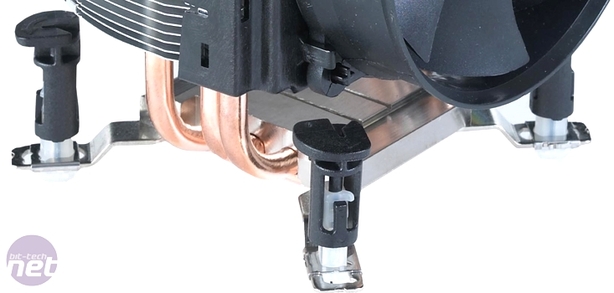
Akasa X4
Manufacturer: AkasaUK Price (as reviewed): £19.19 (inc VAT)
US Price (as reviewed): N/A
The Arctic Cooling Freezer 7 Pro was one of the best budget CPU coolers ever made. You could bag one for around £15 and it would do a damned fine job of taming the temperatures of overclocked Core 2 processors. It was no replacement for a phase-change cooler, but its performance-to-price ratio was formidable. It’s no surprise then that many manufacturers since made lookalikes. Sadly though, few of them were performalikes, a fact which ensured that the Freezer 7 remained seated atop its throne as King of Bargainville.
Today we have another Freezer 7 lookalike, the Akasa X4. At a shade under £20, the X4 is an inexpensive upgrade. Your money buys you a heatsink that opts for the tried-and-tested combination of aluminium fins positioned around a trio of copper heatpipes, which then run through a copper baseplate. While the heatpipes go through the baseplate, they're not smoothly blended into the contact point as seems the be the fashion these days. As we saw in our Tuniq Tower 120 Extreme review though, this technique doesn’t necessarily ensure excellent cooling performance.
The fan is a 92mm model and is removable, allowing you to swap it out for another model if you wish. The X4’s fan plugs into the motherboard via a 4-pin PWM connector, so as long as your motherboard has a 4-pin fan header it can regulate the speed of the fan depending on your CPU temperature. Being a 92mm model, the fan needs to spin faster than a 120mm model to push the same amount of air and this is evident in amount of noise produced. We’ve encountered louder fans, but we’ve come across quieter too. Under full load, particularly on our LGA1156 rig, the fan is noisy when it spins up to max speed.
As with the Freezer 7 Pro, the X4 uses the push-pin mounting system Intel’s reference cooler uses. However, the X4 has a trick up its sleeve. The push-pins click neatly into three different positions, enabling that the X4 to fit LGA775, LGA1156, or LGA1366 motherboards without you needing to so much as think about reaching for the screwdriver. If you’re not familiar with the push-pins, they can seem pretty fiddly at first. However, once you’ve figured out how the mechanism works, it’s a case of lining them up with the holes around the CPU socket, and pushing down until you hear a click.
The installation process on AM2 or AM3 boards also follows a similar process to the AMD reference cooler. A retention arm is bundled that clips the cooler to the socket just like the one that you’ll find in the box of your AMD CPU. Two grooves are cut into the top part of the base plate that guide the direction of the retention arm and hold it in place.

MSI MPG Velox 100R Chassis Review
October 14 2021 | 15:04











Want to comment? Please log in.